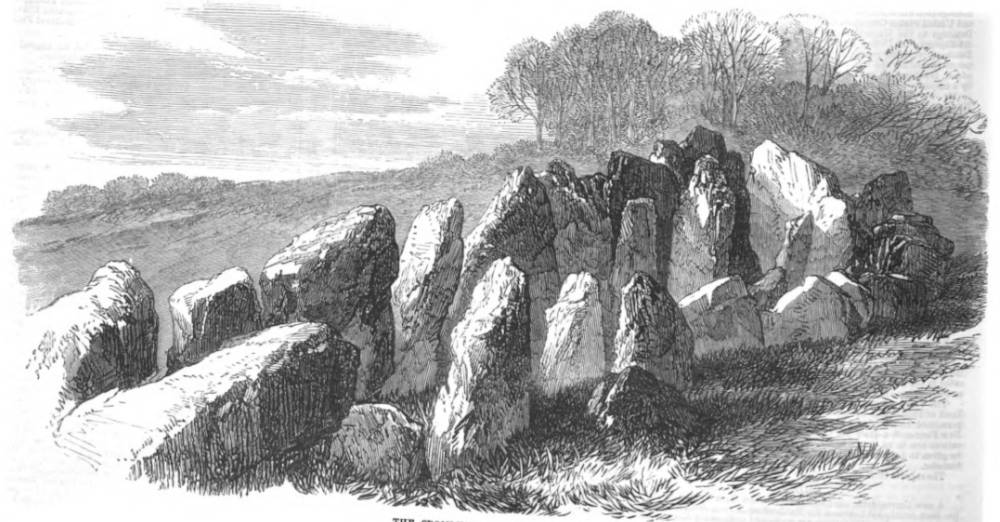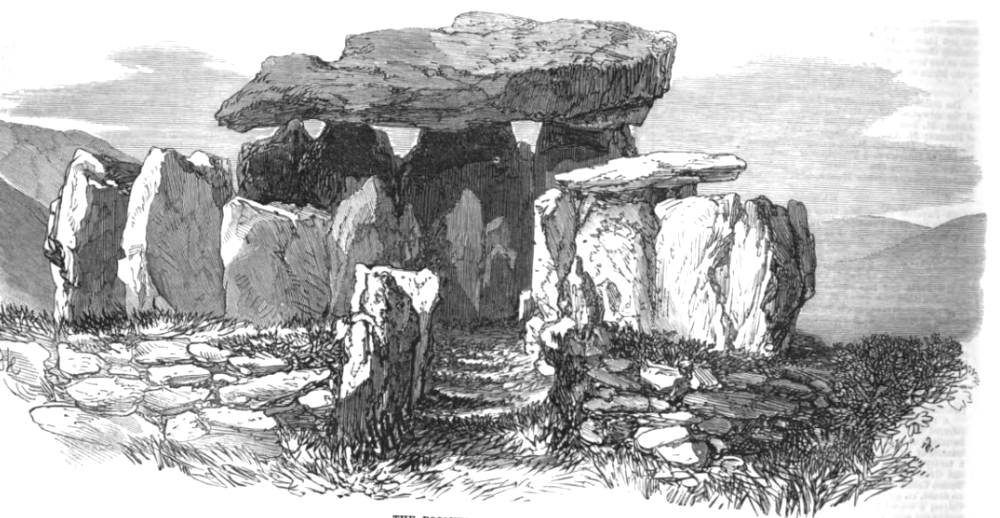In transcribing the following article from the Hathi Trust online version of a copy of the Illustrated London News in the Princeton University Library, I have used ABBYY software to produce the text below. In the original the plates, which I have integrated with the texts, appear seven pages earlier.— George P. Landow

The Menhir le Quesnel. [Click on images to enlarge them.]
An interesting report presented by Lieutenant S. P. direr, of the Royal Artillery, to the members of the Ethnological Society, a few weeks since, will explain the subject of three of our Illustrations. It is only lately that public attention has been turned to the unprotected state of the monuments and relics of past ages in our country. While the Society of Antiqueries has been preparing a list of all historical and regal monuments for the information of Government, the Ethnological Society has also been inquiring into the state of all prehistoric remains found in the British Isles. For this purpose a committee was appointed in March last, and the paper read by Lieutenant Oliver is one of the reports furnished to that committee, being the result of inquiries instituted during the past year.
The report brings to light the deplorable results of our past inattention to these valuable antiquities. It appears that wholesale destruction of them has taken place within the last century. In Jersey, for instance, out of fifty Celtic stone structures mentioned by Poingdestre but very few remain. The finest cromlech in that island was presented to a popular Governor on his leaving the island; and of the four remaining cromlechs only the ruined vestiges remain, of which two have been restored after the ideas of a reverend amateur. In Alderney the navvies employed on the Admiralty works have amused themselves by smashing up all tho megaliths that they could lay their hands on. In the Isle of Herm the quarrymen of a granite company have destroyed, in a like manner, most of the capstones of the numerous cromlechs and circles in that small island. In Sark, or Serque, but one insignificant portion of a kist alone remains extant, where doubtless there were originally numbers. In Guernsey, however, that watchful archaeologist Mr. Lukis has interfered to put a stop to such wanton demolition, but even there often without success.

The Pocquelaye Cromlech.
We proceed to notice a few of then objects separately; and first the Pocquelaye Cromlech, near Gorey Harbour, Jersey. Special mention is made in the report of the Pocquelaye Cromlech. The only portion that was visible twenty years since was the huge capstone; the sustaining props and other stones being entirely hidden beneath the remains of the tumulus which is supposed to have generally covered such structures. About the year 1848 excavations were made which brought to light the side blocks; urul year the cromlech was still further denuded, and its remains exposed, as shown in our Engraving. The name of Pocquelaye, or “fairy-stone,” is that given to the huge capstone by the superstitious peasantry of the island, who believe that the elves and sprites used to hold their revels on this stone. By what means such huge stones as this were lifted or deposited in such a position is still a mysterious problem as yet unsolved. There are not wanting in these days some who will not believe that they were placed by the hand of man, but who think that all such remains as the circles at Avebury and the megalithic avenues in the Morbihan (Brittany) are so many freaks of nature, which, by glacial agencies or other means, has transported those masses from a distance and scattered them as moraines or erratic boulders. But there is little doubt now amongst the most learned archeologists as to the sepulchral character of these stone structures, which further discoveries tend to confirm. In this cromlech, besides the large western chamber covered in by tho chief capstone, are several side cysts, or chambers, one of which is covered with a small capstone. A narrow avenue of stones forms an avenue from the east, at the entrance to which are the remains of two circular walls; but the exact uses of these are scarcely understood.

The Cromlech of Mont St. Ube.
The cromlech at Mont St. Ube, though devoid of all the covering stones, is still very remarkable for the regularity of its form, which exhibits the original plan of the Celtic architects perhaps more perfectly than any other cromlech in the Chaunel Islands. The View given of this cromlech is from its north-eastern corner. It shows the interior of the western chamber, within which are two upright stone pillars showing marks of human hnndiwork. They have evidently been shaped at the top perhaps more fully to adjust the level of the superimposed cupstone. This cromlech is more fully imbedded in the soil than the other above mentioned, which may tend to its longer preservation.
The menhirs, mænhirs, or peulvans, are remarkable monoliths, or pillars of stone, which have been placed in conspicuous positions, at some unknown date, probably to commemorate some signal victory or tho death of some great chieftain. They serve as convenient landmarks, and a superstitious respect is paid to them by the peasantry. The menhir called Lo Quesnel is a good example of these pillars. It is visible from some distance out to sea. It is situated in a rather desolate part of Jersey, not far from Moye Point, the flagstaff of which is a conspicuous object to the passengers in the English steamers that are signalled from here. An iron ring has been fixed to the top of the stone, to which a former proprietor had a stay affixed to prevent the stone being blown down; the stone being so well hulanced that a high wind shakes it. This monument, however, has stood at least 2000 years, and is likely to last as long again, if the quarrymen, who are at work close to it, will let it remain. The remains in Guernsey have more especially been explored and minutely examined by Mr. Lukis, and the results are published by him and his sons, from time to time, in the Archeologia whilst by the liberality of the same veteran the sits of various cromlechs have been purchased in order to ensure their protection. A detailed account of the most interesting cromlechs was given; especial notice being made of the well-known examples at L'Ancresse and Bordeaux Harbour, as well as of a cromlech, not before described, which was recently uncovered at Ville Nouaux, in Jersey. The recent alterations and rearrangement of the stones of the cromlechs of La Couperon and La Pocquelaye were also brought to the notice of the Ethnological Society. The report was fully illustrated by numerous photographs, drawings, maps, plans, and elevations; several of which we are allowed to engrave for this Journal.
[You may use these images without prior permission for any scholarly or educational purpose as long as you (1) credit the Hathi Trust and Princeton University. (2) link your document to this URL in a web document or cite the Victorian Web in a print one.]
Bibliography
“Prehistoric Remains in the Channel Islands.” Illustrated London News (15 January 1870): 60, 68. Hathi Trust online version of a copy of the Illustrated London News in the Princeton University Library. Web. 9 May 2021.
Last modified 9 May 2021